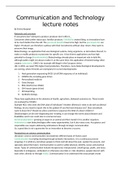Communication and Technology
lecture notes
By Emma Burgwal
Rationale and overview
If consumers don’t demand a product, producer don’t offer it.
Consumers often prefer status quo: familiar products. Familiarity creates liking, so innovations have
to be much better than the old. The perceived benefits have to be high, but the perceived risks are
higher. Producers are therefore cautious with their investments without clear return, they want to
preserve their image.
Biotechnology: an application that uses biological systems, living organisms, or derivatives thereof, to
make or modify products or processes for specific use. It has diverse applications and has high
potential to change (transformative). Biotechnology already plays an important role in daily life,
although public might not always realize it, at the same time, the application of biotechnology often
creates controversy. GMO is for example still illegal in the European Union.
UN: in 2050, we need 70% higher food production. Therefore, more biotechnological developments
are coming, where 8 trends are exemplary for current developments:
1. Next generation sequencing (NGS) (a full DNA sequence of an individual).
2. CRISPR-CAS, including gene drives
3. Personalised medicine
4. Gene therapy
5. RNA interference (RNAi)
6. GM insects (gene drives)
7. 3D bioprinting
8. Synthetic biology
These have applications in the domains of health, agriculture, biobased economy etc. These trends
are analysed by COGEM.
Example NGS: who owns the DNA data of individuals? Another dilemma is what to do with accidental
findings, do you need to report this to the patient (if you find new diseases etc)? Does everybody
want to know this? Should we allow scientists to sequence the DNA of unborn children?
Disadvantages can be over-diagnosing and -treating, it can change the norms about diseases and
disabilities and it can result also in commercial uses.
Xenotransplantation: growing an organ in an animal and then transfer it to another organism.
Ambivalence: new biotechnologies offer many opportunities, but it also raises cons. Acceptance and
responsible use require addressing ambivalence through strategic communication.
So, a good idea is not a guarantee for an innovation to become a success.
Perspectives on science communication
Literature: science communication reconsidered, different types of frames used
Communication is creating meaning through symbolic interactions. It is a continuous process
(ongoing), it is arbitrary and allows people to think and talk about the past, explain the present, and
speculate about the future. Communication is used to satisfy physical, identity, social, and practical
needs. Types of communication include intrapersonal, interpersonal, (small) group, public, and mass.
Especially in ambiguous, ambivalent or otherwise uncertain or crisis situations, people interact with
each other, directly or through media. Communication is to understand the ways people create
, meaning in relation to technology, and how these meanings influence people’s attitudes and
behaviours towards technology. This understanding is necessary to develop communication
strategies to influence
Communication models:
1. The deficit or transmission model (what is the information/knowledge deficiency)
2. The contextual or transactional model (how is a message interpreted by the receiver, and
how does this affect his/her behaviour)
3. The participatory or intersubjective model (how is the meaning constructed through
interactions)
The first model is based on the fact that information has a fixed
(objective) meaning and it is sender-centred (the knowledge of the
sender needs to be transmitted to ‘empty container’). It is based on
information and communication technologies. Criticism: knowledge
acquisition requires context/relevance. Attempts to increase public
knowledge showed no effect. It also has ethical disadvantages (you
say that your own knowledge is more important, you therefore destroy trust in technology).
The second model is more receiver centred, the audience is studied. People use symbolic signals,
such as words, to exchange meaning. A symbolic sign can mean different things to different people
(subjective). Interpretation depends on: history, attention, trust, relationship, etc. You as a sender
are still in control of the subject.
In the third model, communication is actually viewed as meaning making, and thus seen as the
foundation of community and culture. It aims to encourage the public in science policy and debates,
it is democratizing science and incorporating a plurality of views. This process intends to build trust
and relationships.
Framing the message is important. Framing is
about selecting, excluding and emphasising
certain elements over others. Framing is a
structure that selects and organizes central ideas
of an issue, it constructs meaning and presents
interpretative package. Frame functions: problem
definition, casual interpretation, moral evaluation
and propose solution. Red biotechnology
(medical) uses benefit frames and for green
biotechnology (agriculture) often risk frames are
used. Different types of frames will lead to
different interpretations.
Public understanding of biotechnology largely depends on (news) media. There are two media
functions: gatekeeping and selection (what is newsworthy) and framing. The actual content of media
is surprisingly accurate. However, there are some pitfalls: they create hypes (they often use
metaphors), have publication bias, have an error of omission (founding of the source, conflict of
interest etc) and underreporting risks. Mass media communication is a one-to-many, one-way type of
communication. This is for professional production (private/state). Social media results in
interpersonal communication, it is two-way and it has user-generated content.
Self-communication: find what you search (algorithmic filters, information bubbles). Echo chambers:




